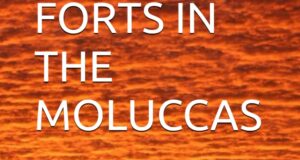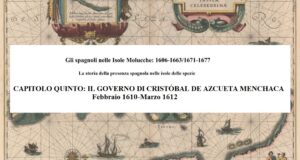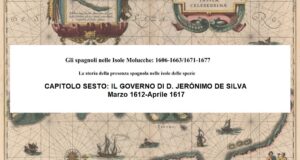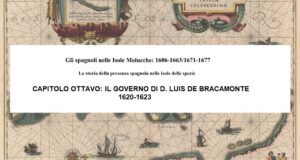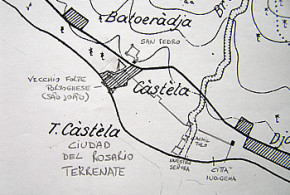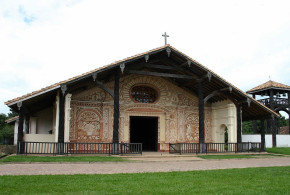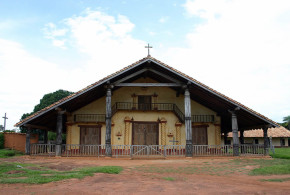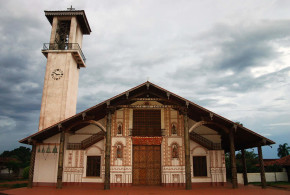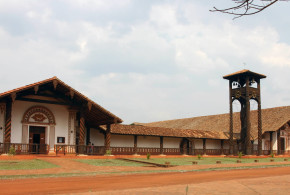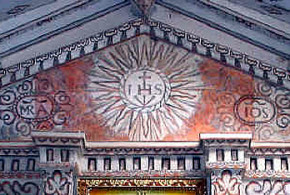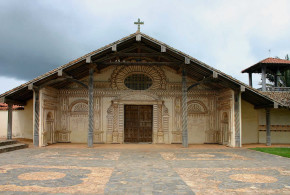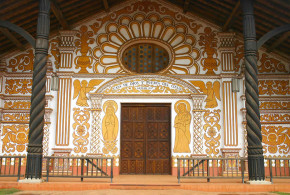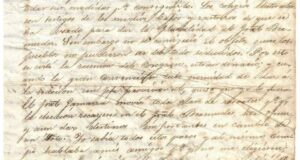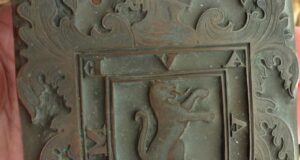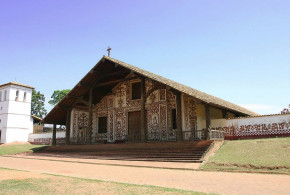This post is also available in:
![]() Italiano
Italiano
The Spaniards in the Moluccas: 1606-1663/1671-1677. The history of the Spanish presence in the spice islands
Written by Marco Ramerini 2005-2020/23
CHAPTER FOUR: THE GOVERNMENT OF LUCAS VERGARA GABIRIA (who performs the functions), March 1609-February 1610
THE APPOINTMENT OF LUCAS VERGARA GABIRIA AS GOVERNOR OF TERNATE
At the beginning of 1609, on the death of Juan de Esquivel, Lucas Vergara Gabiria became governor (who acts as) of Ternate, he had married, shortly before (the day before, according to the source), with an orphan, daughter of a captain who served with his company in Ternate.1 An interesting piece of information on the succession to captain after Esquivel’s death is given to us by the testimony of Fra Rroque de Barrio Nuebo, in fact he informs us that Acuña, in the event of the death of the “mestre de campo” Juan de Esquivel, had nominated as his successor firstly Alarçon and secondly Vergara. It seems that Alarçon renounced the position. Fernando Becerra provides us with some other details (also confirmed by Baltasar (De Ega)), informing us that there were two “provisiones” that indicated Esquivel’s successor. One was from Acuña, and had been kept in the Jesuit headquarters, and the other from the Audiencia which governed the Philippines at Acuña’s death, both of which stated that in the event of Esquivel’s death, the government of Ternate was to be entrusted to Lucas de Vergara Gaviria. 2
Lucas Vergara Gabiria was a Moluccan veteran having come from Spain to the Philippines in 1605. The expedition in which Vergara participated departed from the port of San Lucas de Barameda, together with Esquivel’s troop. Vergara had participated in the conquest of Ternate in 1606. In Ternate he was chosen by Acuña among the 4 captains who first landed on the island. He was among the first soldiers to attack the bastion of Cachil Tulo, which was conquered, and the first to enter the main fortress, which was the house of the King (the old Portuguese fort), making enemies flee through the windows, and to place the Spanish flag there.
Thanks to his courageous conduct he was appointed sergeant major of the Ternate camp. He participated in several successful expeditions against the Ternatese in the island of Halmahera. He obtained the submission of San Juan de Tolo and Morotai. He was greatly respected and loved by his soldiers for his courage and dedication and feared by his enemies for his great aggressiveness. 3 In 1616, Vergara had been serving the King of Spain for over 35 years. On January 26, 1616, Juan de Silva gave him the “encomienda” of the village of Araut in the Philippines. He took part in De Silva’s expedition to Malacca as head of a galleon. 4
The “oidor” Don Juan de la Vega, indicates that the only capable soldier who was present in Ternate was the sergeant major Vergara, he had never failed in the enterprises that had been assigned to him, moreover all that had been conquered by the Spaniards outside Ternate it was due to his work. 5
THE EVENTS OF THE YEAR OF THE GOVERNMENT OF VERGARA
On 23 June 1609, other Dutch ships arrived in Ternate, “tres naos olandesas com hum patacho e duas lanchas” commanded by Vice Admiral François Wittert. Another Dutch “patacho”, however, reported fragmentary news on the peace negotiations between Spain and Holland, which would later lead to the twelve-year truce (1609-1621).6 The Dutch also concluded a new commercial contract with the Ternatese in this period. 7
In the year of Vergara’s government, the Dutch had 14 ships in Ternate and the Ternatese 60 caracoas, with which they besieged the Spanish forts. Despite this enormous power fielded by the enemies, Vergara managed to improve the fortifications of the city of Ternate by replacing the walls of “fajina” with walls of “cal y canto”. According to the testimony of Torralua, this large Dutch fleet seems to have attempted a siege of Tidore, but thanks to the moves of Vergara and the works to improve the defenses that he carried out with great diligence, the Dutch failed to carry out their plans, and this happened in a year when no help was sent to Vergara from Manila. 8
THE CONSTRUCTION OF THE FORT OF SAN PEDRO Y SAN PABLO DE DON GIL
The Spaniards, given the enormous naval overwhelming power of the Dutch, feel surrounded, only Tidore remains their ally. The Dutch planned the construction of another fort in Ternate, almost halfway between the Spanish and Dutch fortresses, on the strait between Ternate and Metara (Maitara) “está o sitio no buquerão que faz esta ilha com otra de Metara pegada com a de Tidore”. The place was located one league from Ternate and was known, according to the testimony of Torralua, with the name of Don Gil “una legua de Terrenate en el sitio que decian de Don Gil”. But the Spanish governor Vergara, having learned of the Dutch intentions, played in advance, in fact, he immediately sent 80 soldiers with 200 “gastadores” to fortify the place. The Dutch attempted to prevent the fort from being built, some ships crossing near where the Spanish were building the fort, but were forced to flee after the Spanish had positioned a cannon overnight to guard the position.
The construction of the fort was soon completed (1609), it will be called “San Pedro y San Pablo en el sitio de Don Jil”9 and was about three-quarters of a league (or a league10) from the Spanish fortress of Ternate, its strategic position forced Dutch ships to avoid the stretch of sea between Ternate and Maitara. The fort then prevented direct attacks on the Spanish fortress of Ternate and also limited the attempts to escape, numerous in periods of food shortages, by slaves and soldiers to the enemy. With the construction of this outpost, the Spaniards also secured a strip of land free from the risk of attacks, and therefore where it was possible to trade and start small crops. The fort was equipped with a large-scale cannon.11
SPANISH FORTIFICATIONS IN THE OTHER ISLANDS
The fortification works of Vergara did not stop with the construction of San Pedro y San Pablo and the improvement of the walls of the city of Ternate. He fortified the post of Marieco and the fort on the island of Tidore, which the Dutch conquered from the Portuguese in 1605. These were places of great importance for the defense of the island of Tidore (“hiço de nuebo los fuertes de Marieco el fuerte vejo de portugueses”). He also fortified San Juan de Tolo, Payayo and Tafongo, all villages located on the island of Halmahera and from where the food for the islands of Ternate and Tidore came.
Vergara in his year of government developed and improved the fortifications considerably, which had not been done in the least by Esquivel in the previous three years. The ensign Torralua tells us that he was sent by Vergara to Payayo to fortify and defend the place, and that a fleet of 10 Caracoa from Ternate and the Dutch attacked the place without success. The fort of Payayo was practically rebuilt again and together with that of Tafongo it allowed the regular flow of food to the Spanish garrisons of the islands of Ternate and Tidore. 12
A NEW DUTCH FLEET
Another Dutch fleet arrived in Ternate on 25 September 1609, it was what remained of the expedition commanded by Admiral Pieter Willemsz. Verhoeff, who had suffered a serious reverse in the Banda Islands where Verhoeff himself had lost his life along with many of his soldiers. 13 The Dutch, after Verhoeff’s death, were commanded by Vice Admiral François Wittert, who arrived with his fleet in Ternate. In 1609 they built a fort on Moti Island, located between Tidore and Maquiem (Machian), the island is rich in cloves.14
THE CONQUEST OF BACHAN BY THE DUTCH
On November 30, 1609, the Dutch commanded by Captain Simon Jansz Hoen occupied the island of Bachan, conquering the small Spanish fort of Labuha.15 In the fight for the fort, 16 Spanish soldiers were killed “sin otros naturales”.16 On this occasion the Dutch made a contract of mutual assistance with the king of Bachan against the Spanish and the Portuguese. 17 It seems that the taking of Bachan was facilitated by the betrayal of the king of the island. 17 Spanish soldiers and some Portuguese casados who had settled on the island defended the fortification. When the Dutch arrived, they were invited to flee by the king who then helped the Dutch to capture them, some soldiers were killed, others were taken prisoner. The sangaje of Bocanora also submitted to the Dutch. 18
Interesting details on a Spanish expedition to help Bachan are reported to us in a document present in the General de las Indias archive in Seville, according to this document (which does not indicate a precise date but most likely certainly refers to this episode) a Spanish expedition was sent to rescue the King of Bachan. The expedition was commanded by the captain don Juan de Espinosa y Sayas, at the head of a boat was Juan de Azevedo and Juan de la Umbria also took part in it. The expedition consisted of the galley captain with 70 soldiers on board and 5 caracoas. After landing on the island, the Spaniards were ambushed by Dutch and Ternatese troops, but the reaction of the Spaniards managed to put the enemies to flight, who also suffered losses. 19
THE SITUATION IN THE MOLUCCAS IN 1610
At the beginning of 1610, when Vergara leaves the post of governor of Ternate to Cristóbal de Azcueta Menchaca, the Dutch have the following fortifications in the Moluccas:20
Makian (Maquién): 3 forts
Bacan (Bachán): 1 fort
Moti (Motel): 1 fort
Ternate: 2 forts
Taliabu, Sula Islands (Taliavo): 1 fort. Here it seems from other sources that the Dutch did not have a fort at the time, but only a resident merchant.
According to a letter from Adriaan Corsz, dated 1610, about 450 Dutch soldiers were stationed in the garrisons of the forts on the islands of Ternate, Bachian, Makian and Moti. 21 In this period the Dutch tried, with attacks on the Spanish bases in the Philippines, to cut off the supplies for the Moluccas so that the Spanish garrisons of Ternate would be forced to surrender by starvation. 22
In November 1609 (they arrived in Oton on 27 October) the Dutch attempted an attack against Ilo Ilo on Oton Island with 5 boats. The sergeant major Fernando de Ayala (appointed captain and sergeant major of the Ternate camp) arrived to relieve the port23, with a company of soldiers who were en route to Ternate. The Dutch withdrew to Cavite and then to Playa Honda in Frayle Harbor where they blockaded the harbor and captured all incoming vessels. In April 1610 the Spanish counterattacked, on the 24th the decisive battle took place in Playa Honda in which the Dutch were severely defeated. Among others in the naval engagement at Playa Honda, Dutch Vice Admiral François Wittert was killed. 24
In April 1611 Vergara was back in Ternate as shown by the “certificacion” present in the “informaciones” of Fernando Centeno Maldonado, dated Ternate, 9 April 1611. He probably had arrived in Ternate with the expedition of Juan de Silva. 25 Later he will go to Manila where he will uselessly ask for permission to be able to return to Spain. In 1611 he will present a petition in which he will ask for the granting of a “terçio” of Spanish infantry in the governments of Cartgena or La Hauana (Havana) and a habit of Santiago as well as an annuity for his services. The opinion of the audience of July 1611 is that he is granted by one of the things he asks for. 26
Vergara will return to Ternate in 1617 again with the position of governor. 27
INDEX
1: The first contacts of the Spaniards with the Moluccas
2: The conquest of Ternate
3: The government of Juan de Esquivel, May 1606-March 1609
4: The government of Lucas de Vergara Gabiria (acting the functions), March 1609-February 1610
5: The government of Cristóbal de Azcueta Menchaca (who performs the duties), February 1610-March 1612
6: The government of D. Jerónimo de Silva, March 1612-April 1617
7: The government of Lucas de Vergara (Bergara) Gabiria (second term), April 1617-February 1620
8: The government of D. Luis de Bracamonte (who performs the functions), February 1620-1623
9: The government of Pedro de Heredia, 1623-1636
10: The government of D. Pedro Muñoz de Carmona y Mendiola (who performs the functions), March (?) 1636-January 1640
11: The last Spanish governors of the Moluccas
12: Bibliography
NOTES
1 (Doc. Mal. III p. 151 Doc. n°38) e (Doc. Mal. III p. 201 Doc. n°56, nota 4)
2 (AGI: “Informaciones Lucas de Vergara Gaviria, 1611” Filipinas,60,N.12)
3 (AGI: “Informaciones Lucas de Vergara Gaviria, 1611” Filipinas,60,N.12)
4 (AGI: “Confirmación de encomienda de Araut, 25-06-1618” Filipinas,47,N.9)
5 (Pastells “Historia general de Filipinas” tomo VI (1608-1618) p. xli AGI 67-6-20)
6 (Doc. Mal. III p. 159 Doc. n°41) Pastells says that Dutch ships arrived at Malayo at the end of May 1609 (Pastells “Historia general de Filipinas” tomo VI (1608-1618) p. lxxxii )
7 (ARA 1.04.02 inv. 550, 551. In: van Veen-Klijn “A guide to the sources…” p. 120)
8 (AGI: “Informaciones Lucas de Vergara Gaviria, 1611” Filipinas,60,N.12)
9 (AGI: “Informaciones Lucas de Vergara Gaviria, 1611” Filipinas,60,N.12)
10 (AGI: “Informaciones Lucas de Vergara Gaviria, 1611” Filipinas,60,N.12)
11 (Doc. Mal. III p. 160-161 Doc. n°41)
12 (AGI: “Informaciones Lucas de Vergara Gaviria, 1611” Filipinas,60,N.12)
13 Dutch Admiral Pieter Willemsz. Verhoeff died on an expedition to Banda where he and several of his crew were ambushed and murdered by natives of Banda Island while negotiating with them for the Dutch East India Company (ARA 1.04.02 inv. 552-555, 560-563 In: van Veen-Klijn “A guide to th sources…” p. 120)
14 (Doc. Mal. III p. 161 Doc. n°41)
15 (Doc. Mal. III p. 8*) e (Doc. Mal. III p. 176 Doc. n°48, nota 7)
16 (Doc. Mal. III p. 180 Doc. n°48A)
17 (ARA 1.04.02 inv. 552-555, 560-563 In: van Veen-Klijn “A guide to th sources…” p. 120)
18 (Pastells “Historia general de Filipinas” tomo VI (1608-1618) pp. lxxxii-lxxxiii)
19 (AGI: “Confirmación de encomienda de Bondoc. Juan de la Umbria. 02-10-1630” Filipinas,48,N.41) (AGI: “Meritos, Juan de Acevedo 1625” Indiferente,111,N.56)
20 (Doc. Mal. III p. 176-177 Doc. n°48)
21 (Van de Wall p. 257)
22 (Pastells “Historia general de Filipinas” tomo VI (1608-1618) p. lxxx)
23 (See: AGI: “Meritos, Fernando de Ayala, 27-07-1643 Indiferente,112,N.47)
24 (Pastells “Historia general de Filipinas” tomo VI (1608-1618) pp. lxxix-lxxx e lxxxiii-xciii AGI 67-6-20)
25 (AGI: “Informaciones Fernando Centeno Maldonado, 1615” Filipinas,60,N.18) Even his statement dated Terrenate, April 3, 1611 confirms this: “Confirmación de encomienda de San Salvador de Palo, etc.Expediente de confirmación de las encomiendas de San Salvador de Palo, Sampoetan y Ormoc en Leyte a Hernando del Castillo. Resuelto, [f] 1623-08-11” FILIPINAS,47,N.58 Bl. 2 f. 7-8
26 (AGI: “Informaciones Lucas de Vergara Gaviria, 1611” Filipinas,60,N.12)
27 (“Carta de Lucas de Vergara Gaviria al Rey defensa Maluco, Terrenate, 31 maggio 1619” AGI Patronato, 47, R. 37) (Pastells “Historia general de Filipinas” tomo VI (1608-1618) pp. clxvii-clxviii, here are some excerpts from Vergara’s letter)
This post is also available in:
![]() Italiano
Italiano
 Colonial Voyage The website dedicated to the Colonial History
Colonial Voyage The website dedicated to the Colonial History


